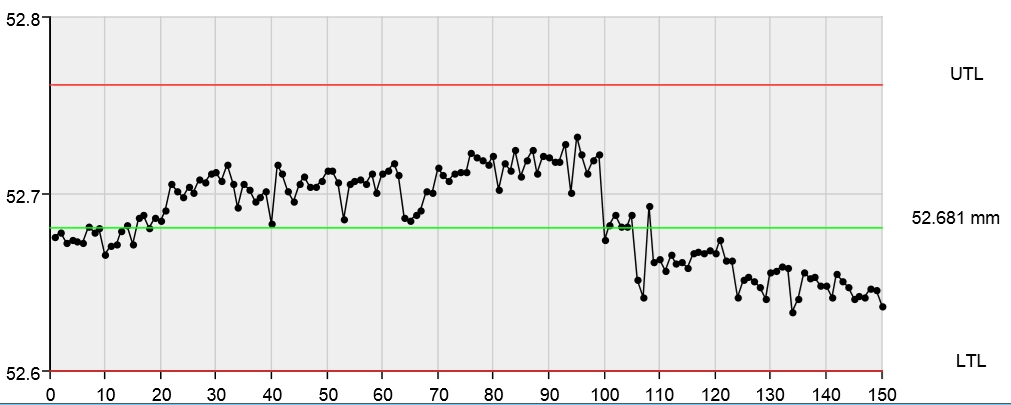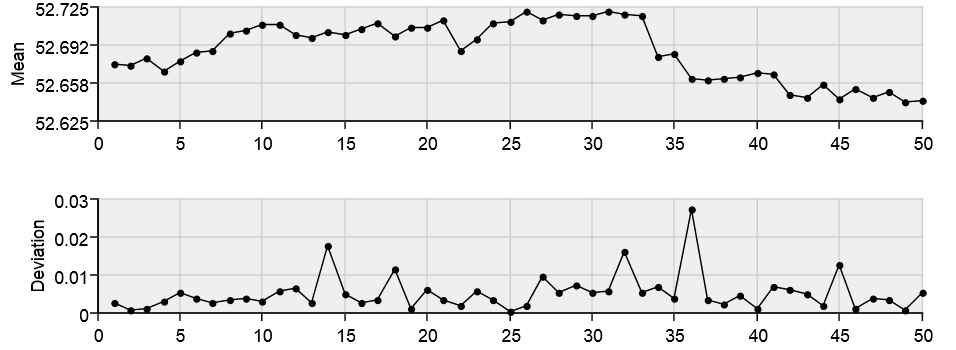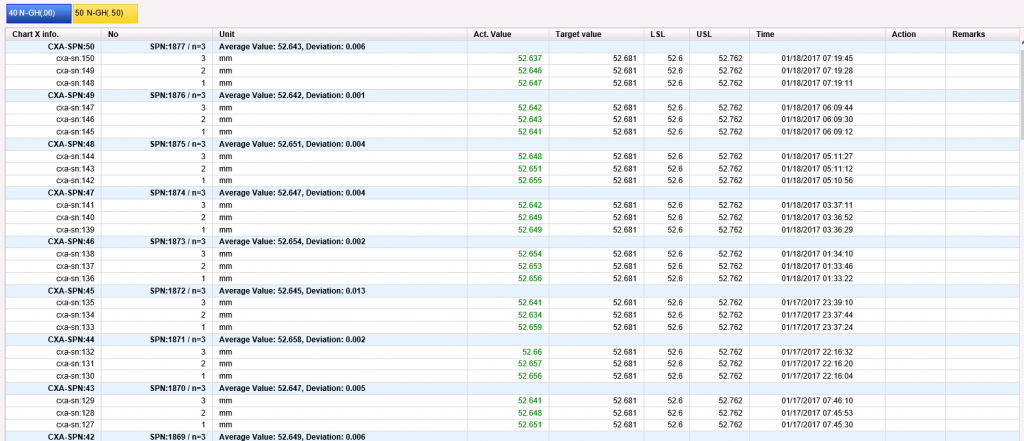By Matthias Kohlbrand In
[vc_row][vc_column][vc_column_text]Statistical process control (SPC) is a tool for the management of quality for achieving a pre-defined level of quality with relatively little effort in the area of quality control.
[caption id="attachment_10880" align="alignright" width="939"]

Fig. 1: A Control Card generated from the Individual Measurements on the Cosmino SPC Dialog.[/caption]
The SPC dialog from Cosmino will accept manually entered as well as automatically acquired values in frequent samples from the statistical process control system and validate them based on the tolerances in the test plan. In addition, an electronic control card with average values and standard deviations will also be displayed.
If the values acquired or the key performance indicators resulting from them (such as Cpk) are out of tolerance, the Cosmino SPC dialog will display the measure to be taken. In addition, the test frequency can be automatically increased in reaction to a process at risk, up to a 100% testing.
The SPC dialog is available as both a component in the Cosmino MES solution as well as in the independent quality assurance module, Cosmino ProControl. The software has been used for more than 25 years in numerous manufacturing operations. The results of the tests are the foundation for process capability indices. The SPC dialog has many other applications in the age of fully automated testing machines. Thanks to the increasing knowledge about the effects of various process parameters on product quality, which cannot all be validated completely and in a fully automated manner, the benefit of using the SPC QA tool is currently increasing.
With the new release, Cosmino users have gotten new options for even more transparent handling of software-supported SPC systems. The ideas for this arose from technical discussions with users and are available now.
1. First, the number of samples that can be displayed at the same time in the live view has been increased. The control card will now show the most recent 50 values (see Fig. 1).
[caption id="attachment_10998" align="aligncenter" width="956"]

Fig. 2: Individual Measurements Chart[/caption]
2. Additional validation test can be defined in case the tester mistypes when manually entering measurement values. This involves testing for unrealistic deviations, which might be caused by misplacement of the decimal point or repetitious entry of the same number. These types of mistakes will not be accepted by the current version of the Cosmino SPC dialog.
3. Actions that should be taken when there are deviations from a tolerance can now also be defined globally instead of individually for each test plan. These global measures will be valid for all test plans for which individual measures have not been determined. Doing this saves time during the creation and maintenance of master data.
4. However, probably the most interesting new feature on the Cosmino SPC dialog is the history of measurement values that can be accessed at any time. It will display the characteristics, values, tolerances, entry date and measures taken for all tests and allows the operator to enter a comment using a notes entry. The fact that all collected information is available is one advantage, which allows an auditor to review quickly, if all tests have been performed in a timely and proper manner. Cosmino will also display a graphical floor plan of the hall, which workstations still have SPC tests to be performed or if they do not correspond to tolerances. Only the status of the current test can be seen from there. Using the history, compliance with the testing process can be depicted for all random samples that were successful.
[caption id="attachment_10997" align="aligncenter" width="940"]

Fig. 3: History of Measurement Values[/caption]
[/vc_column_text][/vc_column][/vc_row]
 Fig. 1: A Control Card generated from the Individual Measurements on the Cosmino SPC Dialog.[/caption]
The SPC dialog from Cosmino will accept manually entered as well as automatically acquired values in frequent samples from the statistical process control system and validate them based on the tolerances in the test plan. In addition, an electronic control card with average values and standard deviations will also be displayed.
If the values acquired or the key performance indicators resulting from them (such as Cpk) are out of tolerance, the Cosmino SPC dialog will display the measure to be taken. In addition, the test frequency can be automatically increased in reaction to a process at risk, up to a 100% testing.
The SPC dialog is available as both a component in the Cosmino MES solution as well as in the independent quality assurance module, Cosmino ProControl. The software has been used for more than 25 years in numerous manufacturing operations. The results of the tests are the foundation for process capability indices. The SPC dialog has many other applications in the age of fully automated testing machines. Thanks to the increasing knowledge about the effects of various process parameters on product quality, which cannot all be validated completely and in a fully automated manner, the benefit of using the SPC QA tool is currently increasing.
With the new release, Cosmino users have gotten new options for even more transparent handling of software-supported SPC systems. The ideas for this arose from technical discussions with users and are available now.
1. First, the number of samples that can be displayed at the same time in the live view has been increased. The control card will now show the most recent 50 values (see Fig. 1).
[caption id="attachment_10998" align="aligncenter" width="956"]
Fig. 1: A Control Card generated from the Individual Measurements on the Cosmino SPC Dialog.[/caption]
The SPC dialog from Cosmino will accept manually entered as well as automatically acquired values in frequent samples from the statistical process control system and validate them based on the tolerances in the test plan. In addition, an electronic control card with average values and standard deviations will also be displayed.
If the values acquired or the key performance indicators resulting from them (such as Cpk) are out of tolerance, the Cosmino SPC dialog will display the measure to be taken. In addition, the test frequency can be automatically increased in reaction to a process at risk, up to a 100% testing.
The SPC dialog is available as both a component in the Cosmino MES solution as well as in the independent quality assurance module, Cosmino ProControl. The software has been used for more than 25 years in numerous manufacturing operations. The results of the tests are the foundation for process capability indices. The SPC dialog has many other applications in the age of fully automated testing machines. Thanks to the increasing knowledge about the effects of various process parameters on product quality, which cannot all be validated completely and in a fully automated manner, the benefit of using the SPC QA tool is currently increasing.
With the new release, Cosmino users have gotten new options for even more transparent handling of software-supported SPC systems. The ideas for this arose from technical discussions with users and are available now.
1. First, the number of samples that can be displayed at the same time in the live view has been increased. The control card will now show the most recent 50 values (see Fig. 1).
[caption id="attachment_10998" align="aligncenter" width="956"] Fig. 2: Individual Measurements Chart[/caption]
2. Additional validation test can be defined in case the tester mistypes when manually entering measurement values. This involves testing for unrealistic deviations, which might be caused by misplacement of the decimal point or repetitious entry of the same number. These types of mistakes will not be accepted by the current version of the Cosmino SPC dialog.
3. Actions that should be taken when there are deviations from a tolerance can now also be defined globally instead of individually for each test plan. These global measures will be valid for all test plans for which individual measures have not been determined. Doing this saves time during the creation and maintenance of master data.
4. However, probably the most interesting new feature on the Cosmino SPC dialog is the history of measurement values that can be accessed at any time. It will display the characteristics, values, tolerances, entry date and measures taken for all tests and allows the operator to enter a comment using a notes entry. The fact that all collected information is available is one advantage, which allows an auditor to review quickly, if all tests have been performed in a timely and proper manner. Cosmino will also display a graphical floor plan of the hall, which workstations still have SPC tests to be performed or if they do not correspond to tolerances. Only the status of the current test can be seen from there. Using the history, compliance with the testing process can be depicted for all random samples that were successful.
[caption id="attachment_10997" align="aligncenter" width="940"]
Fig. 2: Individual Measurements Chart[/caption]
2. Additional validation test can be defined in case the tester mistypes when manually entering measurement values. This involves testing for unrealistic deviations, which might be caused by misplacement of the decimal point or repetitious entry of the same number. These types of mistakes will not be accepted by the current version of the Cosmino SPC dialog.
3. Actions that should be taken when there are deviations from a tolerance can now also be defined globally instead of individually for each test plan. These global measures will be valid for all test plans for which individual measures have not been determined. Doing this saves time during the creation and maintenance of master data.
4. However, probably the most interesting new feature on the Cosmino SPC dialog is the history of measurement values that can be accessed at any time. It will display the characteristics, values, tolerances, entry date and measures taken for all tests and allows the operator to enter a comment using a notes entry. The fact that all collected information is available is one advantage, which allows an auditor to review quickly, if all tests have been performed in a timely and proper manner. Cosmino will also display a graphical floor plan of the hall, which workstations still have SPC tests to be performed or if they do not correspond to tolerances. Only the status of the current test can be seen from there. Using the history, compliance with the testing process can be depicted for all random samples that were successful.
[caption id="attachment_10997" align="aligncenter" width="940"] Fig. 3: History of Measurement Values[/caption]
[/vc_column_text][/vc_column][/vc_row]
Fig. 3: History of Measurement Values[/caption]
[/vc_column_text][/vc_column][/vc_row] 
